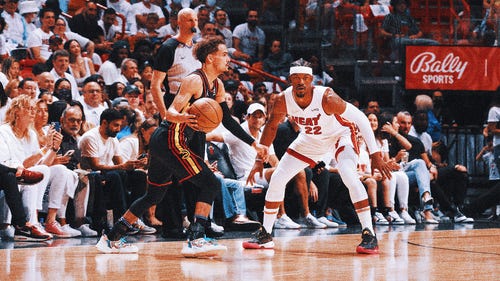
Point guards lead way for Suns
After stumbling out of the starting gate, the Suns proceeded to put on a clinic in routing the Spurs, 110-96, and securing a 3-0 chokehold on the series.
Once the visitors caught their second wind, Grant Hill pulled the trigger on his pull-up jumpers and hit mostly bull's-eyes — 7-of-11 for 18 points. Jason Richardson’s bombs — 5-of-7 from out there — kept Phoenix in touch while the hometown Spurs ran amuck in the opening 12 minutes. Channing Frye did his bit by draining 3-of-5 three-balls.
But it was the Suns point guards who led the way.
For the most part, the Spurs tried to contain Steve Nash by switching whenever he dribbled off a high screen, but this strategy was an unmitigated disaster. Nash hit an assortment of step-back jumpers and drives — five buckets in all — when Tim Duncan left the screener and tried to guard him. Twenty feet from the rim, TD’s size was a handicap, while Nash’s quickness and trickery were unstoppable.
The Spurs did double-team Nash on eight sequences, but their rotations focused too much on protecting the basket and consequently left too many of the Suns' dangerous perimeter shooters unattended. In fact, every time Nash took his dribble past the stripe, a gang of Spurs collapsed into the paint — sometimes all five defenders made the move. In so doing, the Spurs once more left the Suns' shot-makers unguarded.
San Antonio stubbornly kept switching on screens, even when Goran Dragic came off the bench to relieve Nash — and Dragic hurt the Spurs even more than Nash did. Dragic scalded the home team with three-balls (5-for-5), power drives, step-through moves and pull-up jumpers — most accomplished against the likes of Duncan, Richard Jefferson and Antonio McDyess. In only 17 minutes, Dragic recorded 26 points.
There’s no question that Coach Pop is one of the best in the business, but he can also be quite obstinate. This is the only explanation for San Antonio’s insistence to switch bigs on to both Nash and Dragic, despite the profoundly unsatisfactory results.
What the Spurs should have been doing was getting the ball out of Nash’s hands ASAP by doubling him shortly after he stepped across the time line.
With the rest of the team shooting 56.5 percent, Amar’e Stoudemire’s shaky performance wasn’t a factor. He did come up with four assists and three blocks, but Stoudemire also shot only 3-for-10, committed two turnovers and missed three layups.
Phoenix was quicker to the ball and quicker to the hoop. Their weak-side cuts were swift and forceful, their unselfishness was admirable, their spacing on offense was optimal and their defensive rotations were precise. In other words, they played like the Spurs used to.
Even more impressive was that Phoenix never went belly-up when it was down by 18 points in the opening quarter.
Forget about the Lakers, the Magic and the Cavs. Right now, the Suns are playing better than anybody else.
Meanwhile, the Spurs looked old and weary.
Jefferson was 1-for-9 and played like he just joined the team yesterday. The basket seemed to shrink every time George Hill let loose a shot — shooting 1-for-7. And Tony Parker — 5-for-17 —never got his game in gear.
The Suns dug at Duncan, threatened to do so or outright doubled him whenever he caught the ball in the low post. Not that he wasn’t effective in the pivot — five touches there produced six points. But Coach Pop positioned TD mostly around the high-post area, where his main function was to set screens and then roll. As a result, Duncan only managed nine shots.
Another errant tactic.
As ever, Manu Ginobili played his heart out— 10-for-17, five assists, three steals and a game-high 27 points. All in vain.
With all of their experience, habitual exactitude and fundamental soundness, the Spurs have always had to shoot well from the perimeter to beat the league’s elite teams. They did hit their initial three outside jumpers — and when they were hitting, the Suns were missing. However, for the rest of the game, the Spurs made only 14 of their 38 mid- and long-range shots — that’s a losing percentage of 36.8.
San Antonio did push the ball for profit at the get-go, but then it started missing jays just when the Suns started hitting theirs.
Overall, Phoenix demonstrated the latest edition of the Spurs isn’t as quick, as young, or as resourceful as their championship teams of yore once were.
If San Antonio’s version of the Big Three have been caught from behind by Father Time, the ageless Steve Nash (ably abetted by Dragic’s young legs) look to be the front-runners in the Western Conference.
Imagine how fresh and exciting a Phoenix-Lakers matchup will be!








